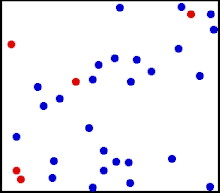Statistical Thermodynamics and Rate Theories/Thermal conductivity
Thermal Conductivity of a gas based on the Kinetic Theory of Gases
[edit | edit source]Kinetic Theory of Gases
[edit | edit source]
The Kinetic Theory of Gases is a set of assumptions about a system of gas particles. These assumptions consider the system in the classical sense, as opposed to a realistic or quantum system. The gas particles are considered as perfectly round spheres, with each sphere having equal mass. It is assumed that a system has a statistically sufficient number of these spheres. Each sphere is assumed to be experiencing a very large number of collusions with other spheres and the boundaries of the system. These collisions are assumed to be perfectly elastic as there is no loss of energy from either sphere upon impact. It is also assumed that each sphere is in constant, random motion within the system. The velocities of the gas particles follow the Maxwell distribution.
Transport Properties of Gases: Momentum
[edit | edit source]Using the Kinetic Theory of gases, the function relating the transport of a property through a gas can be determined. One can imagine two parallel plates along an x-axis separated by some amount a of the z-axis. The area between these plates contains many gas particles. The upper plate moves along the x-axis at some constant velocity. A drag force is acted on this movement by the gas particles between the two plates. This is due to the transfer of momentum from the plate to the gas particles. The shear stress () is defined as the drag force per unit area. The magnitude of this drag force is dependent on the velocity of the plate, the spacing between the two plates, and the type of gas particles in the system. Each gas has a constant that effects the drag force. The viscosity coefficient, defined as , is proportional to the stress the upper plate exerts.
The gas particles nearest both plates are assumed to share equal linear momentum in the x-axis to the respective plates. That is the momentum of gas particles near the plate in motion share equal linear momentum in the direction of plate movement. A function of linear momentum in relation to the height on the z-axis is defined as G(x). It is assumed as well that each gas particle at some value on the z-axis (Z) shares the same momentum as all other gas particles at Z. With this assumption, G(x) can be defined as:
Gas particles closer to the plate in motion will contain a greater momentum. These gas particles will tend to transfer their momentum to particles closer to the stationary plate. This transfer of momentum is defined as momentum flux, and can be expressed by the rate that momentum is transferred across a plane in the system per unit area, per second. The number of particles crossing a given plane within a given time is constrained by the velocity of any given gas particle to cross the plane. The distance the particle would have to travel to pass through the plane within a given time frame is directly related to the velocity of the particle. The net flux of momentum for particles at some height z’ can be determined by integrating the product of the x-momentum of particles at z’ with the number of particles crossing through a plane. By expressing the momentum of the particles in terms of z on the z-axis and substituting G(z’) in terms of G(z) by use of a Taylor series approximation the viscosity coefficient is defined as:
Transport Properties of Gases: Kinetic Energy
[edit | edit source]If the two plates described above are kept stationary but have differing temperatures, a temperature gradient will form between them. Gas particles closer to the higher temperature plate will contain more kinetic energy than the gas particles by the lower temperature plate. This is due to the particles gaining energy when they collide with the higher temperature plate. In much the same way as momentum was transferred through the gas particles, the kinetic energy is also transferred. The rate at which this occurs is measured as the flux (J) of energy through the gas. The flux for a system is equal to the temperature gradient multiplied by the viscosity coefficient (). This flux can then be multiplied by the area of the plate to yield the rate of heat transfer. By defining a new function as the average energy of a particle at height z, one can replace in the above equation to determine the thermal conductivity coefficient.
A more rigorous derivation of the thermal conductivity coefficient based on the Newtonian mechanics of the collisions of gas particles provides a more accurate equation [1]:
This equation has a different numerical prefactor than the simple derivation, but has the same dependence on the temperature and heat capacity.
Interpretation of Thermal Conductivity
[edit | edit source]The thermal conductivity coefficient for a gas is independent of its pressure. The amount of gas within a system does not affect the thermal conductivity coefficient. However, the thermal conductivity is dependent on temperature. An increase in temperature relates directly to an increase in a gases thermal conductivity. Gases with a larger radius, , have a lower thermal conductivity. This is due to the distance traveled between collisions being shorter. A gas particle with a amount of momentum or kinetic energy will travel a shorter distance towards the lower plate, in the system described above, than a gas with shorter .
- ↑ Boltzmann, L. and Brush, S.G. (1964). Lectures on Gas Theory, University of California Press ISBN 0486684555















